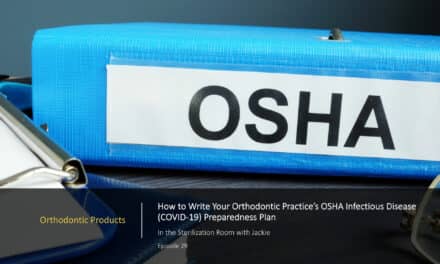Impress leverages new technologies to offer the convenience of a DTC aligner provider with the cost benefits of DSOs while keeping orthodontists at the center of care.
By Steven Martinez
Orthodontics can be slow to change, and it is only in recent years that it has become clear how much the latest advances can offer both better treatment and better profits for doctors. But while orthodontists are still integrating the latest technologies into their practice piecemeal, Impress has jumped in headfirst, leveraging technology from top to bottom to treat patients faster and at a more competitive price.
Co-founded by company chief executive officer Kjeld Aamodt, DDS, MS, Impress has 11 locations in the U.S. and over a hundred clinics and partner-clinics in Europe where Aamodt says they are the top clear aligner provider. While it could be confused for a DSO or even a direct-to-consumer orthodontics company, Impress doesn’t buy out other practices and orthodontists are employees rather than co-owners or partners. It also keeps the orthodontist and their expertise at the center of treatment, requiring patients to come into a physical location for an examination before treatment begins.
“We’re an orthodontic caregiving model and we’re dedicated to figuring out the most delightful, predictable, just wonderful experience to get straight teeth in the modern era,” says Aamodt.
At its core, the company’s model is to create a more affordable and convenient avenue for patients without compromising the quality of care clinicians can provide. Aamodt says that in doing so, it is mostly trying to tap into the adult market who might forgo treatment because it’s too burdensome or costly. While children and young adults are the lifeblood of many private practices, Impress is geared toward an older market who are less inclined to pay to fix their own smile.
“We’re really geared towards the young professionals that are digitally native adults. [We’re] not looking to compete with that long tail of existing orthodontists who are currently serving a population of youth and adolescents in suburban areas,” says Aamodt.
Before starting Impress, Aamodt was director of predoctoral orthodontics at the University of California San Francisco School of Dentistry, where he also completed his orthodontic residency. As a professor, he taught courses on clear aligners and emerging technologies and while there he began to see that the orthodontics profession and business were evolving. Doctors were having to increase their patient volume and find ways to better manage costs for a price-sensitive public.
“Back in 1970, we could buy a car or straighten our teeth for the same amount of money,” says Aamodt. “Over the years, prices of cars have gone up, but the prices of orthodontics have actually, adjusted for inflation, gone down. The only way for orthodontists to continue their standard of living was to see more patients.”
Having spent time in private practice as an associate and in high-volume corporate practices, Aamodt found that orthodontists in each model were struggling with the same issues.
“Patients were angry that they had to take off work and school and every month, to zigzag their way to straightness with broken brackets and pokey wires, and unsightly appliances and spending so much money and only getting to see me for a little bit of time,” he says. “That frustrated me. I realized that we didn’t have to do it that way.”
Operating out of Silicon Valley, the heart of technology development and disruptor mindset, Aamodt says he started working with a “hacker” to create new software that would take advantage of the latest tech to improve the life of both the doctor and patient.
Treatment planning was one of the first areas that Aamodt sought to improve upon. When he first came across CBCTs and intraoral scanners in dental school, Aamodt was impressed with the information they could provide for treatment but felt there was still a disconnect in how the data was being used.
“It just blew my mind when I was practicing in San Francisco as a young kid that I had a 3D x-ray in the room and I had a 3D scanner in the room, but they didn’t make each other any smarter. I couldn’t use the information to make my treatment better,” says Aamodt. “It made my diagnosis a little bit better if I could see an impacted tooth was on this side versus that side. But it didn’t make the actual 3D printing and design and modeling of tooth movement for my aligner or braces patients any better.”
His team created software that combined a 3D x-ray with a 3D scan of a patient’s teeth to provide orthodontists with the clearest possible view of a patient’s mouth to streamline the treatment planning process. The software could provide information on roots, the density of the bone, and the jaw joint. A doctor could then see how teeth are physically shaped, combined with a surface scan to create devices for them that modeled more biologically sensible tooth movement.
“I realized we could remove that guesswork like this by combining the 3D x-ray of the tooth, roots, bone, jaw joints, with a 3D scan with a patient’s teeth so that we actually knew where the teeth were to begin with,” says Aamodt. “We created a patent that merged those two together and that means that when we design each 3D-printed aligner, it’s actually how that tooth wants to move. Because we’ve calculated the center of resistance for that tooth.”
He says that using the combined data through Impress’s software could reduce the number of patient visits from an average of 24 with braces to around three visits for an average case at Impress. That said, Impress is very much a clear aligner focused model. It doesn’t manufacture its own aligners, that job is mostly tasked to third-party companies with some in-house 3D printing as well. But all the designs come from the company’s treatment planning software. The software is also hardware agnostic. Aamodt says it is compatible with any CBCT and intraoral scanner equipment that produces DICOM and STL files.
In addition to its treatment planning software, Impress incorporated technology in other areas. The company created a remote monitoring app for patients that Aamodt calls “a personal trainer for your teeth.” The app allows Impress doctors to monitor treatment weekly and motivate patients to stay accountable on their end. Patients can use the app to submit insurance information, handle third-party financing, or order new retainers. The app can also be used to answer questions or concerns that might come up during treatment.
Lastly, the company created an electronic health record (EHR) that helps to coordinate the treatment process and enhance the decision making for doctors. The idea behind the EHR was to close the gap Aamodt had seen between experienced and less-experienced doctors when it came to aligner treatments.
“We want to flatten the learning curve by using this guided clinical decision-making software that helps orchestrate the patient journey from start to finish,” says Aamodt. “We have this digital AI augmented safety net for patients and doctors so that patients don’t fall through the cracks. Patients get the best treatment plans, and we can really improve diagnosis and follow up care so that you get that high touch experience. But it’s much less burdensome on the practice and on the doctor and allows us to reduce the costs at the same time through delegation to technology.”
The EHR also centralizes a patient’s data making it possible for patients to visit any Impress clinic to continue treatment. Once treatment is started at one location, subsequent patient appointments can be made at any of its locations around the country, all of which are in or near major metropolitan areas. For instance, if a college student starts aligner treatment at home and attends school in another state, they can still continue their in-person appointments at either location.
Despite the focus on convenience, every patient is required to come into a clinic and be seen by an orthodontist during treatment. Aamodt is adamant that he is against trying to remove the orthodontist from the doctor-patient relationship during orthodontic treatment, saying, “We think that’s incredibly dangerous. It’s not healthcare.”
“We’re dedicated to making orthodontic care better for patients and for doctors. We’re not here to put orthodontists out of business. That’s not our goal,” says Aamodt. “We’re here to expand the pie for all of us and give care to people that orthodontists have historically chosen to neglect.”OP
Photo courtesy of Impress










